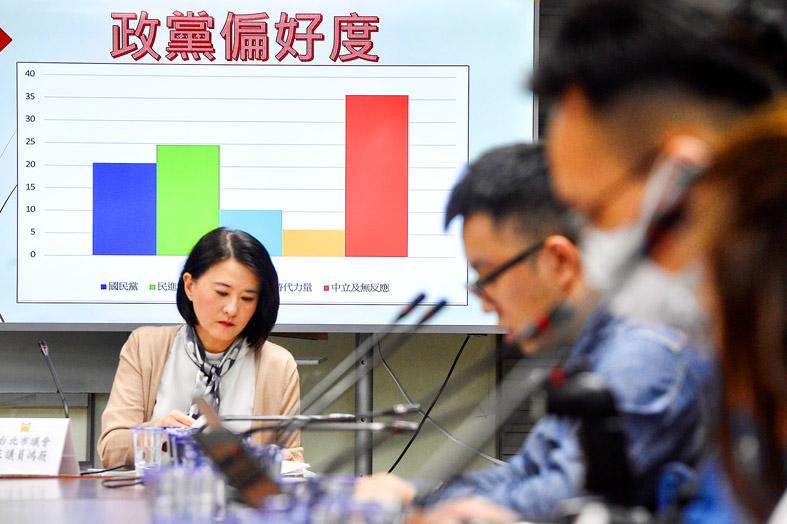More than 70 percent of the public disagrees that Taiwan should allow imports of US pork containing ractopamine residue, even though this might entail further US support, a survey released yesterday by the Chinese Nationalist Party (KMT)- affiliated National Policy Foundation found.
The survey, which was conducted from Tuesday to Thursday last week, asked members of the public whether they agreed with the statement: “In order for the US to support Taiwan more, we should allow imports of US pork containing leanness-enhancing agents.”
It found that 72.3 percent of respondents disagreed with the statement, while 20.3 agreed, the foundation said.

Photo: George Tsorng, Taipei Times
Asking whether people supported the import of the US pork regardless of its effect on Taiwan-US ties, the survey found that 70.6 percent of respondents disagreed, while 22.8 percent agreed.
A survey last month found that 65.9 percent of respondents opposed imports of pork containing ractopamine, KMT Legislator Hsieh Yi-fong (謝衣鳳) told a news conference in Taipei.
The more Taiwanese understood the issue and the closer it gets to the lifting of the import ban on Jan.1, the more they oppose the policy, Hsieh said, urging the government to “respect public opinion.”
Polls conducted by the Taiwanese Public Opinion Foundation this month and last month also showed an increase of about 5 percent in the opposition to allowing the imports, KMT Taipei City Councilor Wang Hung-wei (王鴻薇) said.
This month’s foundation survey also found that 20.9 percent of people said that Beijing would “bully Taiwan even more” after US president-elect Joe Biden takes office on Jan. 20.
However, 61.6 percent of respondents disagreed, and 17.5 percent of respondents gave “no response,” the survey found.
It also showed that 19.3 percent of respondents agreed with a statement that the Democratic Progressive Party (DPP) administration might be able to “negotiate a better consensus than the ‘1992 consensus,’” with Beijing, while 58.9 percent disagreed, and 21.8 percent gave “no response.”
The “1992 consensus,” a term former Mainland Affairs Council chairman Su Chi (蘇起) admitted making up in 2000, refers to a tacit understanding between the KMT and the Chinese Communist Party (CCP) that both sides acknowledge there is “one China,” with each side having its own interpretation of what “China” means.
The survey also showed that 90.8 percent of respondents were against abolishing the death penalty, compared with 4.7 percent who were in favor of abolishing it.
Asked which political party they supported, 24.7 percent of people said that they favored the DPP, and 20.6 percent said they supported the KMT, the survey showed.
Another 10.4 percent said that they favored the Taiwan People’s Party, 6 percent said they supported the New Power Party, and 1.5 percent said they supported the Taiwan Statebuilding Party, it found.
A total of 36.1 percent of respondents either said they were neutral or had “no response” to party preference, the survey showed.
The gap in support for the KMT and the DPP is closing, foundation vice president Huang Hsin-hua (黃心華) said, adding that the gap was 4.1 percentage points, while the poll last month recorded a gap of 6.3 percentage points.
The survey results were based on telephone interviews with 1,078 people aged 20 or older, the foundation said.
The survey was conducted by Taiwan Real Survey and had margin of error of 2.98 percentage points, it added.

Taiwanese scientists have engineered plants that can capture about 50 percent more carbon dioxide and produce more than twice as many seeds as unmodified plants, a breakthrough they hope could one day help mitigate global warming and grow more food staples such as rice. If applied to major food crops, the new system could cut carbon emissions and raise yields “without additional equipment or labor costs,” Academia Sinica researcher and lead author the study Lu Kuan-jen (呂冠箴) said. Academia Sinica president James Liao (廖俊智) said that as humans emit 9.6 billion tonnes of carbon dioxide compared with the 220 billion tonnes absorbed

The Taipei Mass Rapid Transit (MRT) Wanda-Zhonghe Line is 81.7 percent complete, with public opening targeted for the end of 2027, New Taipei City Mayor Hou You-yi (侯友宜) said today. Surrounding roads are to be open to the public by the end of next year, Hou said during an inspection of construction progress. The 9.5km line, featuring nine underground stations and one depot, is expected to connect Chiang Kai-shek Memorial Hall Station to Chukuang Station in New Taipei City’s Jhonghe District (中和). All 18 tunnels for the line are complete, while the main structures of the stations and depot are mostly finished, he

Taipei is to implement widespread road closures around Taipei 101 on Friday to make way for large crowds during the Double Ten National Day celebration, the Taipei Department of Transportation said. A four-minute fireworks display is to be launched from the skyscraper, along with a performance by 500 drones flying in formation above the nearby Nanshan A21 site, starting at 10pm. Vehicle restrictions would occur in phases, they said. From 5pm to 9pm, inner lanes of Songshou Road between Taipei City Hall and Taipei 101 are to be closed, with only the outer lanes remaining open. Between 9pm and 9:40pm, the section is

China’s plan to deploy a new hypersonic ballistic missile at a Chinese People’s Liberation Army Rocket Force (PLARF) base near Taiwan likely targets US airbases and ships in the western Pacific, but it would also present new threats to Taiwan, defense experts said. The New York Times — citing a US Department of Defense report from last year on China’s military power — on Monday reported in an article titled “The missiles threatening Taiwan” that China has stockpiled 3,500 missiles, 1.5 times more than four years earlier. Although it is unclear how many of those missiles were targeting Taiwan, the newspaper reported